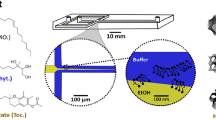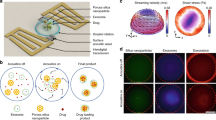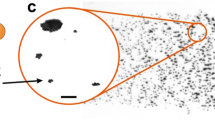Abstract
Interaction of spherical particles with cells and within animals has been studied extensively, but the effects of shape have received little attention. Here we use highly stable, polymer micelle assemblies known as filomicelles to compare the transport and trafficking of flexible filaments with spheres of similar chemistry. In rodents, filomicelles persisted in the circulation up to one week after intravenous injection. This is about ten times longer than their spherical counterparts and is more persistent than any known synthetic nanoparticle. Under fluid flow conditions, spheres and short filomicelles are taken up by cells more readily than longer filaments because the latter are extended by the flow. Preliminary results further demonstrate that filomicelles can effectively deliver the anticancer drug paclitaxel and shrink human-derived tumours in mice. Although these findings show that long-circulating vehicles need not be nanospheres, they also lend insight into possible shape effects of natural filamentous viruses.
This is a preview of subscription content, access via your institution
Access options
Subscribe to this journal
Receive 12 print issues and online access
$259.00 per year
only $21.58 per issue
Buy this article
- Purchase on Springer Link
- Instant access to full article PDF
Prices may be subject to local taxes which are calculated during checkout





Similar content being viewed by others
References
Singh, R. et al. Tissue biodistribution and blood clearance rates of intravenously administered carbon nanotube radiotracers. Proc. Natl Acad. Sci. USA 103, 3357–3362 (2006).
Cai, D. et al. Highly efficient molecular delivery into mammalian cells using carbon nanotube spearing. Nature Methods 2, 449–454 (2005).
Kam, N. W. S., Dai, H. J. Carbon nanotubes as intracellular protein transporters: Generality and biological functionality. J. Am. Chem. Soc. 127, 6021–6026 (2005).
Shortridge, K. F. et al. Characterization of avian H5N1 influenza viruses from poultry in Hong Kong. Virology 252, 331–342 (1998).
Geisbert, T. W. & Jahrling, P. B. Exotic emerging viral diseases: progress and challenges. Nature Med. 10, S110–S121 (2004).
Roberts, P. C., Lamb, R. A., Compans, R. W. The M1 and M2 proteins of influenza A virus are important determinants in filamentous particle formation. Virology 240, 127–137 (1998).
Ma, Q., Remsen, E. E., Clark, C. G. Jr ., Kowalewski, T., Wooley, K. L. Chemically induced supramolecular reorganization of triblock copolymer assemblies: trapping of intermediate states via a shell-crosslinking methodology. Proc. Natl Acad. Sci. USA. 99, 5058–5063 (2002).
Jain, S. & Bates, F. S. On the origins of morphological complexity in block copolymer surfactants. Science 300, 460–464 (2003).
Discher, D. E. & Eisenberg, A. Polymer vesicles. Science 297, 967–973 (2002).
Gabizon, A., Shmeeda, H. & Barenholz, Y. Pharmacokinetics of pegylated liposomal doxorubicin: review of animal and human studies. Clin. Pharmacol. 42, 419 (2003).
Klibanov A. L., Maruyama, K., Torchilin, V. P., & Huang L. Amphipathic polyethyleneglycols effectively prolong the circulation times of liposomes. FEBS Lett. 268, 235–237 (1990).
Photos P., Discher, B. M., Bacakova, L., Bates, F. S., Discher, D. E. Polymer vesicles in vivo: correlations with PEG molecular weight. J. Control Release 90, 323–334 (2003).
Geng, Y. & Discher, D. E. Hydrolytic shortening of polycaprolactone-block-(polyethylene oxide) worm micelles. J. Am. Chem. Soc. 127, 12780–12781 (2005).
Srinivas, G., Discher, D. E. & Klein, M. L. Self-assembly and properties of diblock copolymers by coarse-grain molecular dynamics. Nature Mater. 3, 638–644 (2004).
Oldenborg, P. A. et al. Role of CD47 as a marker of self on red blood cells. Science 288, 2051–2054 (2000).
Merril, C. R. et al. Long-circulating bacteriophage as antibacterial agents. Proc. Natl Acad. Sci. USA 93, 3188–3192 (1996).
Simpson-Holley, M. et al. A functional link between the actin cytoskeleton and lipid rafts during budding of filamentous influenza virions. Virology 301, 212–225 (2002).
Gref, R. et al. Biodegradable long-circulating polymeric nanospheres. Science 263, 1600–1603 (1994).
Akerman M. E., Chan, W. C. W., Laakkonen, P., Bhatia, S. N. & Ruoslahti, E. Nanocrystal targeting in vivo. Proc. Natl Acad. Sci. USA 99, 12617–12621 (2002).
Baskerville, A., Bowen, E. T., Platt, G. S., McArdell, L. B. & Simpson, D. The pathology of experimental Ebola virus infection in monkeys. J. Pathol. 125, 131–138 (1978).
Nishimura, H., Itamura, S., Iwasaki, T., Kurata, T. & Tashiro, M. Characterization of human influenza A (H5N1) virus infection in mice: neuro-, pneumo- and adipotropic infection. J. Gen. Virol. 81, 2503–2510 (2000).
Larson, R. G. The Structure and Rheology of Complex Fluids (Oxford Univ. Press, New York, 1999).
Dalhaimer, P., Bates, F. S. & Discher, D. E. Single molecule visualization of stiffness-tunable, flow conforming worm micelles. Macromolecules 36, 6873–6877 (2003).
MacDonald, I. C., Schmidt, E. E. & Groom, A. C. The high splenic hematocrit: a rheological consequence of red cell flow through the reticular meshwork. Microvasc. Res. 42, 60–76 (1991).
Doi, M. & Edwards, S. F. The Theory of Polymer Dynamics 1st edn (Oxford Univ. Press, Oxford, 1986).
Wasylnka, J. A. & Moore, M. M. Uptake of Aspergillus fumigatus Conidia by phagocytic and nonphagocytic cells in vitro: quantitation using strains expressing green fluorescent protein. Infect. Immunol. 70, 3156–3163 (2002).
Yavlovich, A., Tarshis, M. & Rottem, S. Internalization and intracellular survival of Mycoplasma pneumoniae by non-phagocytic cells. FEMS Microbiol. Lett. 233, 241–246 (2004).
Champion, J. A. & Mitragotri, S. Role of target geometry in phagocytosis. Proc. Natl Acad. Sci. USA 103, 4930–4934 (2006).
Song, L., Kim, U. S., Wilcoxon, J. & Schurr, J. M. Dynamic light scattering from weakly bending rods: estimation of the dynamic bending rigidity of the M13 virus. Biopolymers 31, 547–567 (1991).
Parato, K. A., Senger, D., Forsyth, P. A. & Bell, J. C. Recent progress in the battle between oncolytic viruses and tumours. Nature Rev. Cancer 5, 965–976 (2005).
Mathis, J. M., Stoff-Khalili, M. A. & Curiel, D. T. Oncolytic adenoviruses—selective retargeting to tumor cells. Oncogene 24, 7775–7791 (2005).
Kim, T. Y. et al. Phase I and pharmacokinetic study of Genexol-PM, a cremophor-free, polymeric micelle-formulated paclitaxel, in patients with advanced malignancies. Clin. Cancer Res. 10, 3708–3716 (2004).
Weissig, V., Whiteman, K. R. & Torchilin, V. P. Accumulation of protein-loaded long-circulating micelles and liposomes in subcutaneous Lewis lung carcinoma in mice. Pharmacol. Res. 15, 1552–1556 (1998).
Savic, R., Luo, L., Eisenberg, A. & Maysinger, D. Micellar nanocontainers distribute to defined cytoplasmic organelles. Science 300, 615–618 (2003).
Hamaguchi, T. et al. NK105, a paclitaxel-incorporating micellar nanoparticle formulation, can extend in vivo antitumour activity and reduce the neurotoxicity of paclitaxel. Br. J. Cancer 92, 1240–1246 (2005).
Shenoy, D., Little, S., Langer, R. & Amiji, M. Poly(ethylene oxide)-modified poly(beta-amino ester) nanoparticles as a pH-sensitive system for tumor-targeted delivery of hydrophobic drugs: part 2. In vivo distribution and tumor localization studies. Pharmacol. Res. 22, 2107–2114 (2005).
Shoji, J., Tanihara, Y., Uchiyama, T. & Kawai, A. Preparation of virosomes coated with the vesicular stomatitis virus glycoprotein as efficient gene transfer vehicles for animal cells. Microbiol. Immunol. 48, 163–174 (2004).
Ewert, K., Ahmad, A., Evans, H. M. & Safinya, C. R. Cationic lipid–DNA complexes for non-viral gene therapy: relating supramolecular structures to cellular pathways. Expert Opin. Biol. Ther. 5, 33–53 (2005).
Ahmed, F. et al. Shrinkage of a rapidly growing tumor by drug-loaded polymersomes: pH-triggered release through copolymer degradation. Mol. Pharmacol. 3, 340–350 (2006).
Graff, A., Sauer, M., Van Gelder, P. & Meier, W. Virus-assisted loading of polymer nanocontainer. Proc. Natl Acad. Sci. USA 99, 5064–5068 (2002).
Napoli, A., Valentini, M., Tirelli, N., Muller, M. & Hubbell, J. A. Oxidation-responsive polymeric vesicles. Nature Mater. 3, 183–189 (2004).
Shuai, X., Ai, H., Nasongkla, N., Kim, S. & Gao, J. Micellar carriers based on block copolymers of poly(epsilon-caprolactone) and poly(ethylene glycol) for doxorubicin delivery. J. Control Release 98, 415–426 (2004).
Maeda, H. Enhanced permeability and retention (EPR) effect: basis for drug targeting to tumor. pp. 211–278. In Biomedical Aspects of Drug Targeting (eds Muzykantov, V. R. & Torchilin, V. P.) (Kluwer Academic, Boston, 2002).
Arap, W., Pasqualini, R. & Ruoslahti, E. Cancer treatment by targeted drug delivery to tumor vasculature in a mouse model. Science 279, 377–380 (1998).
Geng, Y. & Discher, D. E. Visualization of degradable worm micelle breakdown in relation to drug release. Polymer 47, 2519–2525 (2006).
Acknowledgements
The authors thank S. Goundla for the simulation snapshot of Fig. 1a, and the Bates Laboratory at the University of Minnesota for OE copolymers. This work was funded by NIH grants (DED), Penn's NSF-MRSEC, NTI, and NSEC (NBIC), and Penn's Institute for Translational Medicine and Therapeutics.
Author information
Authors and Affiliations
Corresponding authors
Ethics declarations
Competing interests
The authors declare no competing financial interests.
Supplementary information
Supplementary Information
Supplementary figures S1—S5 (PDF 288 kb)
Rights and permissions
About this article
Cite this article
Geng, Y., Dalhaimer, P., Cai, S. et al. Shape effects of filaments versus spherical particles in flow and drug delivery. Nature Nanotech 2, 249–255 (2007). https://doi.org/10.1038/nnano.2007.70
Received:
Accepted:
Published:
Issue Date:
DOI: https://doi.org/10.1038/nnano.2007.70
This article is cited by
-
Multifunctional nanocarriers for targeted drug delivery and diagnostic applications of lymph nodes metastasis: a review of recent trends and future perspectives
Journal of Nanobiotechnology (2023)
-
Advances in nanomedicines for lymphatic imaging and therapy
Journal of Nanobiotechnology (2023)
-
Digital micelles of encoded polymeric amphiphiles for direct sequence reading and ex vivo label-free quantification
Nature Chemistry (2023)
-
Nucleic acid drug vectors for diagnosis and treatment of brain diseases
Signal Transduction and Targeted Therapy (2023)
-
Engineering nanomaterial physical characteristics for cancer immunotherapy
Nature Reviews Bioengineering (2023)



